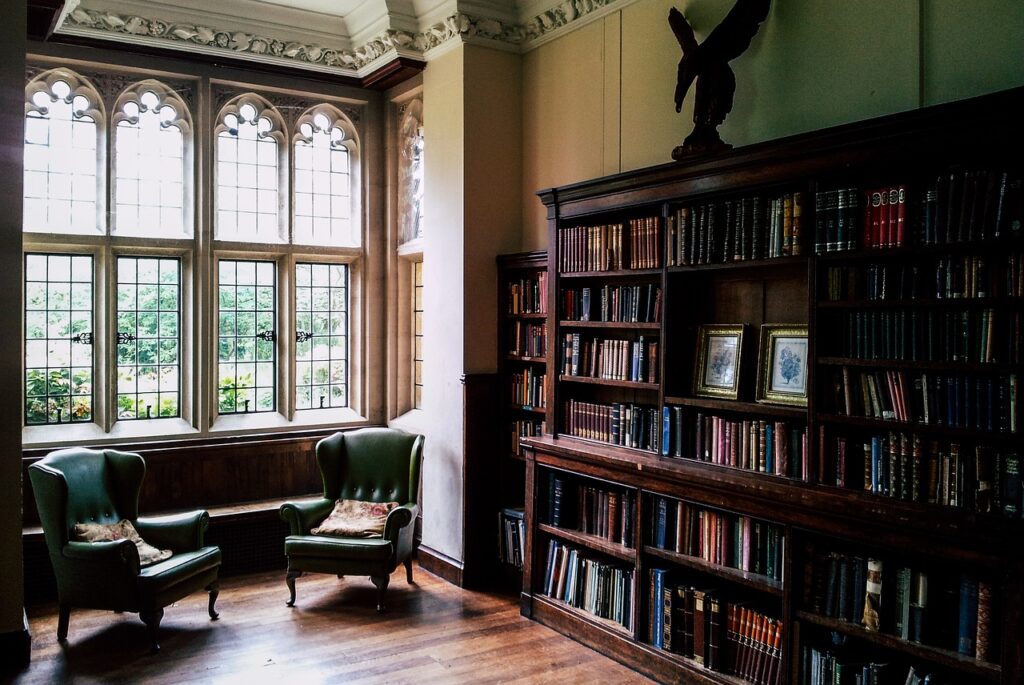IELTSアカデミックリーディングの概要
IELTSのアカデミックリーディングテストは、60分間で約2,500語の3つのパッセージ(長文)からなる40問の問題に答える形式です。各設問では、大意を読む、主要な考えを読む、詳細を読む、スキミング、論理的な議論を理解する、著者の意見、態度、目的を認識するといった幅広い読解力が試されます。
3つのパッセージ(長文)は、記述的なものから事実に基づいたもの、論議的なもの、分析的なものまで多岐にわたります。これらは書籍、ジャーナル、雑誌、新聞から選ばれており、大学の授業に参加する人々や専門職の登録を求める人々が理解できるよう一般向けに選ばれています。
問題タイプは多岐にわたり、多肢選択、情報の特定、著者の意見や主張の特定、情報のマッチング、見出しのマッチング、特徴のマッチング、文章の完成、要約の完成、ノートの完成、表の完成、フローチャートの完成、図表ラベルの完成、短回答問題などが含まれています。
時間配分
各パッセージ(長文)は一般的にパッセージ1からパッセージ3へと難易度が増していき、パッセージ1は最も易しく、パッセージ3は最も難しい傾向にあります。
時間配分については、すべてのパッセージと質問を完了するためには効率的な時間管理が必要です。パッセージ1が比較的易しいため、これを早めに終えることができれば、最後のパッセージ3にはより多くの時間を割くことができます。
以上より、次のような時間配分が目安となります。
・パッセージ1 15分
・パッセージ2 20分
・パッセージ3 25分
問題タイプ
IELTSの公式ウェブサイトでは次の14の問題タイプに分類されています。
1.Multiple choice(多肢選択問題)
2.Identifying information (TRUE, FALSE, NOT GIVEB問題)
3.Identifying the writer’s views/claims (YES, NO, NOT GIVEN問題)
4.Matching information(情報の一致問題)
5.Matching headings(見出しの一致問題)
6.Matching features(特徴の一致問題)
7.Matching sentence endings(文の終わりの一致問題)
8.Sentence completion(文の穴埋め問題)
9.Summary completion(要約の穴埋め問題)
10.Note completion(ノートの穴埋め問題)
11.Table completion(表の穴埋め問題)
12.Flow chart completion(フローチャートの穴埋め問題)
13.Diagram label completion(図表のラベルの穴埋め問題)
14.Short answer questions(短答問題)
これらの問題タイプを大きなカテゴリーに分けると次のようになります。
1.穴埋め問題(文、要約、ノート、表、フローチャート、図表のラベル)
2.TRUE, FALSE, NOT GIVEN / YES, NO, NOT GIVEN問題
3.多肢選択問題
4.マッチング問題(見出し、情報、特徴、文の終わり)

問題を解く順番
この4つの中で、キーワードから該当箇所を探して解ける問題を最初に手をつけると効率的です。具体的には、1.穴埋め問題、2.TRUE, FALSE, NOT GIVEN / YES, NO, NOT GIVEN問題、3.多肢選択問題です。
4.マッチング問題(特にパラグラフの見出し問題)は読む範囲が広く、解答の根拠を探すのに時間がかかります。見出し問題は、穴埋め問題などでいくつかのパラグラフを読んだ後であれば内容が理解できているので、すでに読み終えたパラグラフの見出しは比較的容易に選べます。
見出し問題はパッセージの最初の設問になることがあります。その場合でも、見出し問題から手をつけず、穴埋め問題やTRUE, FALSE, NOT GIVENから先に着手するほうが効率的に解くことができます。
問題の解き方
1.穴埋め問題(文、要約、ノート、表、フローチャート、図表のラベル)の解き方
最初に文字数の確認を最初にします。ONE WORD ONLYであれば1語、NO MORE THAN TWO WORDSなら、1語または2語です。
次に問題文中の空欄の前後から固有名詞などのキーワードをいくつか選んで、そのキーワード(言い換え表現含む)をもとにパッセージを頭からスキャニングします。
このキーワード選定とパッセージをスキャニングして該当箇所を速く見つけることがとても大切です。スキャニングでは詳細な理解よりもパッセージ内でキーワードを見つけることに専念します。
【例題】IELTS 14 Academic Student’s Book TEST2の19番(ONE WORD ONLY)
Professor Alan Short examined the work of John Shaw Billings, who influenced the architectural ________ of hospitals to ensure they had good ventilation.
この問題のキーワードはAlan Short, examined, John Shaw Billings, influenced, architectural, hospitals, ventilationです。パッセージをスキャニングするとパラグラフDにShort 、John Shaw Billings、hospitals、ventilationの派生語であるventilatedやventilatingが見つかります。
パラグラフDの前半部分
Short’s book highlights a developing and sophisticated art and science of ventilating buildings through the 19th and earlier-20th centuries, including the design of ingeniously ventilated hospitals. Of particular interest were those built to the designs of John Shaw Billings, including the first Johns Hopkins Hospital in the US city of Baltimore (1873-1889).
次に該当箇所の読解をします。見つけたキーワードの前後の文を注意深く読みます。この時点で詳細な読解が必要です。穴埋めの答えは通常、キーワードの直前、直後、あるいは近くにあります。
この例題では、designsが正解となります。ひとつの問題を終えたら次の問題にとりかかり、キーワードを同じように選びます。穴埋め問題では、通常、解答の根拠の箇所が順に出てくるので、抜き出した箇所の後からキーワードを探します。
2.TRUE, FALSE, NOT GIVEN / YES, NO, NOT GIVEN問題の解き方
穴埋め問題と同じように、問題文の中からキーワードをいくつか選びます。
【例題】IELTS 14 Academic Student’s Book TEST1の1番
Henderson rarely visited the area around Press Estate when he was younger.
この問題のキーワードはHenderson, rarely visited, around Press Estate, youngerです。パッセージをスキャニングすると、第一パラグラフにPress Estateがあります。
第1パラグラフ
Alexander Henderson was born in Scotland in 1831 and was the son of a successful merchant. His grandfather, also called Alexander, had founded the family business, and later became the first chairman of the National Bank of Scotland. The family had extensive landholding in Scotland. Besides its residence in Edinburgh, it owned Press Estate, 650 acres of farmland about 35 miles southeast of the city. The family often stayed at Press Castle, the large mansion on the northern edge of the property, and Alexander spent much of his childhood in the area, playing on the beach near Eyemouth or fishing in the streams nearby.
“The family often stayed at Press Castle, the large mansion on the northern edge of the property, and Alexander spent much of his childhood in the area”からHendersonは子供の時、Press Estateでよく過ごしたことがわかります。
これにより問題文のHenderson rarely visited the area around Press Estate when he was younger.は「ヘンダーソンは若い頃、プレスエステートの周辺を訪れることはほとんどなかった。」は間違っていることがわかり、答えはFALSEになります。

3.多肢選択問題
穴埋め問題と同じように、問題文の中からキーワードをいくつか選びます。そしてスキャニングにより該当箇所を探します。該当箇所が見つかればその前後を中心に読み、解答の根拠となるセンテンス、フレーズを見つけ、それに合う選択肢を選びます。
【例題】IELTS 14 Academic Student’s Book TEST1 Passage 2 19、20番)
Which TWO of the following statements are made in the text about the Amsterdam bike-sharing scheme of 1999?
A It was initially opposed by a government department.
B It failed when a partner in the scheme withdrew support.
C It aimed to be more successful than the Copenhagen scheme.
D It was made possible by a change in people’s attitudes.
E It attracted interest from a range of bike designers.
この問題のキーワードはAmsterdam, bike-sharing, scheme, 1999です。パッセージをスキャニングすると、パラグラフDにAmsterdam, bike-sharing , 1999があります。パラグラフD以降に根拠があると想定して読んでいきます。
パラグラフD
Schimmelpennink never stopped believing in bike-sharing, and in the mid-90s, two Danes asked for his help to set up a system in Copenhagen. The result was the world’s first large-scale bike-share programme. It worked on a deposit: ‘You dropped a coin in the bike and when you returned it, you got your money back.’ After setting up the Danish system, Schimmelpennink decided to try his luck again in the Netherlands – and this time he succeeded in arousing the interest of the Dutch Ministry of Transport. ‘Times had changed,’ he recalls. ‘People had become more environmentally conscious, and the Danish experiment had proved that bike-sharing was a real possibility.’ A new Witte Fietsenplan was launched in 1999 in Amsterdam. However, riding a white bike was no longer free; it cost one guilder per trip and payment was made with a chip card developed by the Dutch bank Postbank. Schimmelpennink designed conspicuous, sturdy white bikes locked in special racks which could be opened with the chip card – the plan started with 250 bikes, distributed over five stations.
パラグラフD内の”People had become more environmentally conscious”( 人々の環境意識が高まっていた)から、一つ目はD It was made possible by a change in people’s attitudes.(人々の意識の変化により実現された)が正解であることがわかります。
パラグラフE
Theo Molenaar, who was a system designer for the project, worked alongside Schimmelpennink. ‘I remember when we were testing the bike racks, he announced that he had already designed better ones. But of course, we had to go through with the ones we had.’ The system, however, was prone to vandalism and theft. ‘After every weekend there would always be a couple of bikes missing,’ Molenaar says. ‘I really have no idea what people did with them, because they could instantly be recognised as white bikes.’ But the biggest blow came when Postbank decided to abolish the chip card, because it wasn’t profitable. ‘That chip card was pivotal to the system,’ Molenaar says. ‘To continue the project we would have needed to set up another system, but the business partner had lost interest.’
パラグラフDの”a chip card developed by the Dutch bank Postbank”( オランダの銀行Postbankが開発したチップカード)とパラグラフEの”Postbank decided to abolish the chip card”( Postbankがチップカードの廃止を決定した)からB It failed when a partner in the scheme withdrew support.を選択します。
4.マッチング問題(見出しを例にします)の解き方
難易度が高めのものが多いのが見出しのマッチング問題です。穴埋め問題、TRUE, FALSE, NOT GIVEN / YES, NO, NOT GIVEN問題、多肢選択問題で読み終えたパラグラフから着手します。選択肢を見て、該当する見出しを選びます。
【例題】IELTS 14 Academic Student’s Book TEST2 Passage3 27番)
Section A
Organisation is big business. Whether it is of our lives – all those inboxes and calendars – or how companies are structured, a multi-billion dollar industry helps to meet this need.
We have more strategies for time management, project management and self-organisation than at any other time in human history. We are told that we ought to organize our company, our home life, our week, our day and seven our sleep, all as a means to becoming more productive. Every week, countless seminars and workshops take place around the world to tell a paying public that they ought to structure their lives in order to achieve this.
This rhetoric has also crept into the thinking of business leaders and entrepreneurs, much to the delight of self-proclaimed perfectionists with the need to get everything right. The number of business schools and graduates has massively increased over the past 50 years, essentially teaching people how to organise well.
List of Headings
i Complaints about the impact of a certain approach
ii Fundamental beliefs that are in fact incorrect
iii Early recommendations concerning business activities
iv Organisations that put a new approach into practice
v Companies that have suffered from changing their approach
vi What people are increasingly expected to do
vii How to achieve outcomes that are currently impossible
viii Neither approach guarantees continuous improvement
ix Evidence that a certain approach can have more disadvantages that advantages
下線部の箇所がヒントとなり、vi What people are increasingly expected to doを選びます。

公認テキストの解説サイト
IELTS 14 Academic Student’s Bookのような公認問題集のリーディングは解答のみで解説がついていませんが、英語で解説を公開しているサイトがあります。キーワードの選定、パラフレーズ、解答の根拠などがまとめられています。
こうしたサイトを利用することで、解答の根拠を確認することができ、学習効率を上げると思います。日本語の解説が欲しい場合は、DeepLなどの翻訳サイトを使って日本語化することができます。
まとめ
IELTSアカデミックリーディングで高得点を獲得するためには、各問題の特性、種類、そして効率的な解き方を把握し、それに基づく練習を重ねることが欠かせません。特にIELTS独特の問題形式、たとえばTRUE、FALSE、NOT GIVEN問題などを解くためのテクニックを身につけることが、スコアアップの鍵となります。
TOEFLや英検のリーディングでは、問題が基本的にパラグラフ単位で出題されますが、IELTSではその範囲がパッセージ全体に及びます。穴埋め問題などは問題文のキーワードを元に解答の根拠を探し出す能力が求められます。このため、キーワードを迅速にスキャニングして探し出すスキルは、IELTSアカデミックリーディングを効率的に解くためには極めて重要となります。
さらに、3つのパッセージを60分で解くという制限時間内で問題を完了するためには、時間管理が不可欠です。問題タイプごとの解き方と解くべき順序を理解し、それを日々の練習に活かすことで、問題を解く速度を向上させ、より高いスコアを獲得するための基盤を築くことができるでしょう。
さらに、公認問題集を活用することも重要です。これらの問題集はIELTSの実際のテストと同じ形式で問題が作られており、公式の試験環境を模した形での練習が可能です。さらに、詳細な解説を提供しているウェブサイトもありますので、それらを活用し、自己の理解を深め、問題解決スキルを鍛え上げることが、高得点獲得のための追加の戦略となります。
